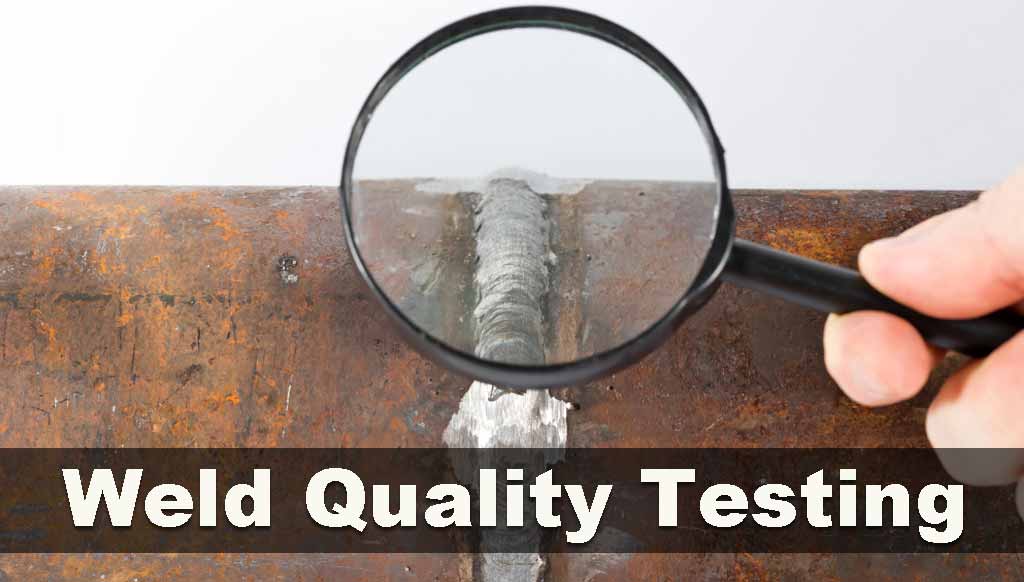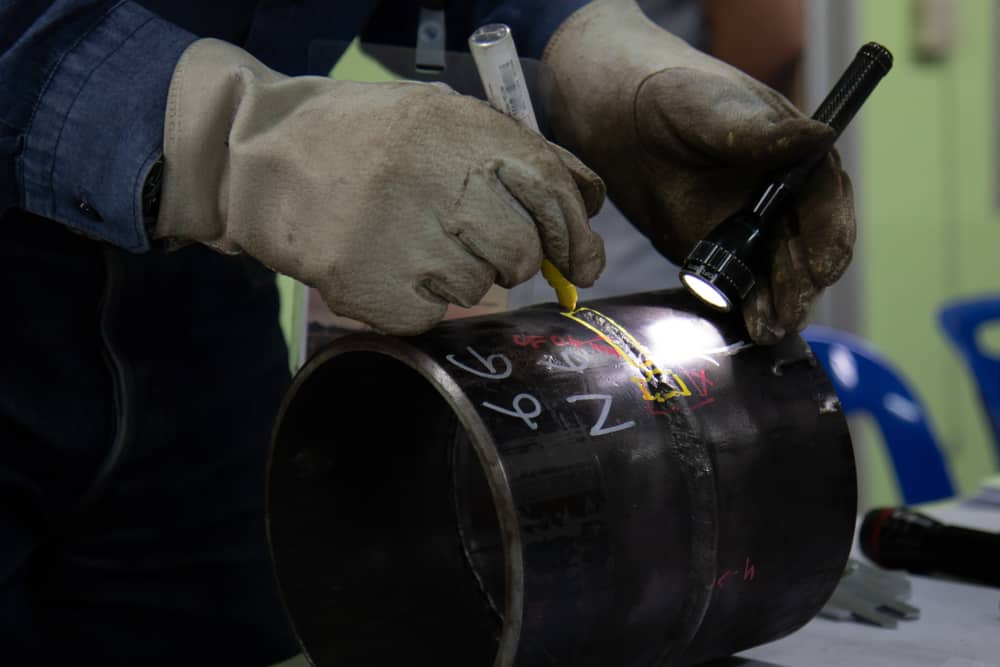Secret Aspects to Think About in Welding Assessment for High Quality Assurance
Welding inspection is an important facet of quality control that includes different elements vital for guaranteeing the integrity of bonded frameworks. Secret considerations include the option of suitable evaluation techniques, the qualifications of employees, and adherence to market standards. The performance of different examination methods-- such as aesthetic, ultrasonic, and radiographic testing-- can considerably affect the outcomes of quality assessments. Robust paperwork practices are important for maintaining traceability and facilitating constant renovation. The interaction of these elements elevates further inquiries concerning how they can be enhanced to improve overall welding quality.
Types of Welding Procedures
Welding procedures incorporate a selection of strategies made use of to join materials, mostly steels, with the application of warm, stress, or both. The most typical kinds of welding procedures include arc welding, gas welding, resistance welding, and solid-state welding.
Arc welding, that includes techniques like Shielded Steel Arc Welding (SMAW) and Gas Tungsten Arc Welding (GTAW), uses an electrical arc to create warmth for thawing the base steels and filler materials. Gas welding, typically described as oxy-fuel welding, utilizes a flame produced by burning a fuel gas with oxygen to melt the metals.
Resistance welding, including spot and seam welding, relies upon the warm generated from electrical resistance to bond products, typically used in auto production. Solid-state welding procedures, such as friction welding and ultrasonic welding, sign up with products without melting them, using mechanical stress and frictional warmth.
Each welding procedure has particular applications, strengths, and limitations, making the option of the proper method vital for accomplishing desired weld quality and efficiency. Welding Inspection Milwaukee. Comprehending these processes is crucial for ensuring effective welding practices and supporting top quality guarantee in fabrication and production markets
Examination Strategies and Tools
To ensure the honesty and dependability of welded joints, numerous assessment techniques and devices are employed throughout the welding process. These techniques can be generally categorized right into non-destructive testing (NDT) and harmful screening (DT) methods. NDT approaches, which do not compromise the stability of the welded element, include aesthetic inspection, ultrasonic testing, radiographic screening, magnetic particle testing, and fluid penetrant testing.
Aesthetic inspection is the most basic method, permitting the prompt identification of surface issues. Ultrasonic screening uses high-frequency acoustic waves to discover inner defects, while radiographic screening uses X-rays or gamma rays to envision the internal structure of welds. Magnetic fragment testing is efficient for discovering surface area and near-surface gaps in ferromagnetic products, and liquid penetrant testing reveals surface-breaking flaws by using a tinted dye or fluorescent penetrant.
On the other hand, harmful testing entails literally testing the welded joint until failure to evaluate its mechanical residential or commercial properties. Tools such as tensile screening equipments, influence testers, and hardness testers are generally utilized in this context. By utilizing a mix of these devices and strategies, assessors can ensure the quality and safety of welded structures.

Relevance of Paperwork
In the world of welding assessment, correct documents works as a critical foundation for high quality guarantee and regulatory compliance. Documents encompasses a variety of documents, consisting of weld procedure requirements, evaluation records, and non-destructive testing outcomes. These records not just offer a sequential account of the evaluation procedure but likewise act as a recommendation for future analyses and audits.
Precise documents makes sure that all welding activities are verifiable and deducible, helping with adherence to pertinent industry criteria and codes. It becomes necessary during the evaluation procedure, allowing stakeholders to evaluate conformity with specifications and identify any kind of flaws or variances. Additionally, extensive records sustain efficient interaction amongst staff member and outside auditors, cultivating a society of transparency and responsibility.
In addition, well-kept paperwork can significantly decrease the danger of costly rework or failures. By guaranteeing that all needed info is taped and obtainable, organizations can enhance their quality guarantee processes, eventually improving the honesty of the welded structures. Investing time and sources right into producing robust documents techniques is not simply a procedural requirement but a critical imperative for attaining long-lasting success in welding operations.
Personnel Qualifications and Training
Just how can organizations ensure the expertise of their welding workers? To keep high criteria of high quality assurance, it is essential for companies to buy thorough training programs customized to the particular needs of the welding sector. Welding Inspection Milwaukee. This includes not just preliminary training however also continual education to maintain workers abreast of evolving technologies and methodologies
Organizations needs to establish clear standards for personnel credentials, including pertinent accreditations and experience in numerous welding techniques. Utilizing certified welding assessors (CWIs) can enhance the top quality of inspections, as these experts have the necessary expertise to determine possible problems and make sure adherence to best methods.
Along with technological skills, organizations must cultivate a culture of security and conformity amongst their welding employees. Supplying normal workshops and correspondence course can help enhance the value of safety and security procedures and the effects of non-compliance.
Furthermore, organizations need to apply performance assessments and comments devices to analyze personnel proficiency Full Article gradually. By methodically resolving training demands and advertising a commitment to top quality, companies can boost their welding inspection processes, ultimately leading to boosted product honesty and customer contentment.
Conformity With Sector Requirements
Adhering to industry standards is paramount for ensuring the high quality and safety of welding procedures. Conformity with well established requirements, such as those established by the American Welding Society (AWS), American National Requirement Institute (ANSI), and International Company for Standardization (ISO), offers a framework for assessing the integrity of bonded frameworks. These criteria include different aspects of welding, consisting of product choice, layout specs, and procedural strategies.
Welding assessments need to be carried out based on these standards to validate that the work meets the needed high quality criteria. This includes aesthetic evaluations, non-destructive testing (NDT), and detailed paperwork of findings. Ensuring conformity not only boosts the dependability of the welds but additionally mitigates threats connected with structural failings.
Moreover, adherence to sector standards cultivates a culture of safety and security and professionalism within the labor force. It establishes a criteria for efficiency and motivates continual enhancement via regular audits and training. Eventually, conformity is not just a regulatory requirement; it is a dedication to excellence that secures both personnel and the atmosphere while delivering top notch welding products.

Verdict

Welding examination is a vital facet of quality guarantee read what he said that encompasses different variables important for making certain the stability of bonded frameworks.To guarantee the honesty and reliability of bonded joints, different examination techniques and tools are used throughout the welding process.In the realm of welding assessment, correct paperwork offers as a vital foundation for top quality guarantee blog here and regulatory compliance.Welding assessments have to be conducted in accordance with these requirements to confirm that the work fulfills the needed quality standards.In conclusion, efficient welding inspection for quality assurance needs a diverse technique that incorporates the selection of appropriate examination strategies, rigorous adherence to industry standards, and comprehensive documents of results.